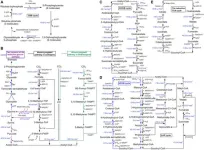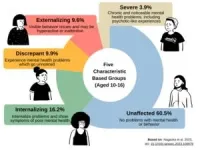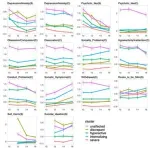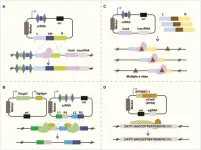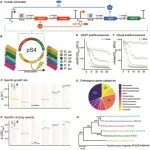(Press-News.org)
Fossil fuels are at the heart of most human activities, contributing to the increase in greenhouse gas emissions and the ever-rising atmospheric carbon dioxide (CO2) levels. CO2 levels are projected to increase exponentially in future, resulting in severe environmental and ecological impacts. A beacon of hope amidst this chaos are eco-friendly alternatives to fossil fuels.
Green energy sources can be developed using advanced biotechnological techniques. One such intervention is the use of biorefineries or microbial cell factories, that convert biomass (organic matter like plants and solid waste) into energy and valuable by-products. The first (1G) and second (2G) generation biorefineries produce biofuels and valuable chemicals from sugar-based feedstocks and biomass, respectively. The third generation (3G) biorefineries are now becoming increasingly popular and aim to produce beneficial products from one-carbon (C1) sources like CO2, formaldehyde (HCHO), formic acid (HCOOH), methane (CH4), and methanol (CH3OH). Why C1 sources? C1 sources produce sustainable energy from chemical bond breakdown, electricity, and/or natural light.
In a new study, Prof. Yajie Wang from Westlake University, China, along with her colleagues Wei Zhong and Hailong Li, reviewed the progress made in the development of artificial biological systems for 3G refineries over the last decade. Their findings were published on 31 October 2023 in Volume 5 of BioDesign Research. Prof. Wang remarks, “This promising technology represents an important step toward sustainable development, and it can help address some of modern society's most pressing environmental challenges. However, to compete with the petroleum industry, it is critical to identify the most viable pathways for C1 utilization, as well as the productivity and yield of the target products.”
The authors discussed three important artificial systems utilizing C1, namely, artificial autotrophic organisms, tandem enzymatic systems, and chemo-bio hybrid systems. Such systems are either reconstructed based on the natural system or created from scratch.
Microorganisms are mostly heterotrophs, i.e. they depend on external sources for food and energy. However, with the advancement of biotechnology, heterotrophs can now be engineered to chemoautotrophs, that derive energy from the breakdown of chemical substances like C1. Several microbes, including bacteria and yeasts like E. coli, P. pastoris, S. cerevisiae, and Candida boidinii have been modified to produce enzymes and cofactors of natural C1 utilization pathways, they do not otherwise possess. However, energy imbalance, oxygen sensitivity, and poor enzyme activities have been major limitations in the development of C1 utilizing efficient chemoautotrophs.
Tandem enzymatic systems combine multiple enzymes that function together for C1 fixation. Various scientists have independently developed many artificial C1 fixation pathways in different microorganisms. One of the most noteworthy developments is the CETCH (crotonyl-CoA/ethylmalonyl-CoA/hydroxybutyryl-CoA) pathway that has outperformed chemical as well as natural fixation pathways. Although theoretically these systems claim to maximize yield, there are limitations such as the requirement of purified enzymes and well-controlled reaction conditions.
Chemo-bio hybrid systems combine biocatalysts like microbial enzymes or whole cells with electrocatalytic and/or photocatalytic systems to synthesize value-added compounds from CO2. These systems have several advantages over the conventional enzymatic process such as use of renewable energy, high-energy conversion efficiency, and wide range of biocatalysts with varied selectivity and specificity. Depending on the combination of systems, there are various types of hybrids that fix C1- electroenzymatic, electromicrobial, photoenzymatic, and photomicrobial systems.
While foreseeing a very promising future of artificial biological systems, Prof. Yajie remarks enthusiastically, “Creating an artificial biological system that can use C1 sources is an impactful research attempt because of their abundant sources, potential for sustainable and carbon-neutral production, and lack of conflict with food security.”
To summarize, with progressive advancements in biotechnology, artificial biological systems will usher in a new era of sustainable energy.
###
References
Authors
Wei Zhong1, Hailong Li1,2, and Yajie Wang1
Affiliations
1Westlake Center of Synthetic Biology and Integrated Bioengineering, School of Engineering, Westlake University, China
2School of Materials Science and Engineering, Zhejiang University, China
About Professor Yajie Wang
Dr. Yajie Wang is an Assistant Professor at the Westlake Center of Synthetic Biology and Integrated Bioengineering, Westlake University, China. She established the WangSynbio lab soon after joining the Westlake University in 2021. Her research group focuses on integrating protein engineering, synthetic biology, chemistry, material sciences, and machine learning to establish a “Design-Build-Test-Learn” platform to design and construct artificial chemo-bio hybrid systems to harness the synthetic power from both chemistry and biology. She has received the Singapore National Scholar and the recipient of “35 Innovators Under 35 (TR35)” in China 2022.
END
The personal yet global struggle with mental health may be more visible now than ever before. Yet many people still find it difficult to access the support they need. In Japan, suicide is sadly the leading cause of death for young people. Researchers, including from the University of Tokyo, have carried out a six-year study to better understand the myriad of factors which can impact adolescent mental health. After surveying 2,344 adolescents and their caregivers, and using computer-based deep learning to process the results, they were able to identify five categories which the young people could be grouped into. Nearly 40% of those involved were ...
Improving the mental health and wellness of Black Americans requires acknowledging and confronting systemic racism underlying the US political, social, and healthcare systems that create and maintain racial inequality in every aspect of life for Black people in the USA.
The new Series of three papers on Black mental health in the USA, plus an essay from Black Americans with lived experience, published inThe Lancet Psychiatry journal, outlines the overwhelming evidence for the role racism plays in producing, maintaining, and amplifying mental health disparities for Black Americans. Against this background, the authors call for a comprehensive analysis of the conditions and systems in ...
UK organisations responsible for protecting the public from prescription-only drug adverts are putting patients at risk from the harms of weight loss drugs by not enforcing the law, reveals an investigation published by The BMJ today.
Legal responsibility for regulating adverts for medicines in the UK rests with the Medicines and Healthcare products Regulatory Agency (MHRA) on behalf of health ministers. But there is also a system of self-regulation with a number of bodies operating their own codes of practice, including the Advertising Standards Authority (ASA).
But The BMJ has found that the MHRA has not issued a single sanction for prescription drugs in the last ...
Researchers at Sinai Health have unearthed vital information about the relationship between insulin levels after eating and long-term heart and metabolic health. The research upends the notion that insulin surge following food intake is a bad thing.
On the contrary – it could be an indicator of good health to come.
Led by Dr. Ravi Retnakaran, Clinician-Scientist at the Lunenfeld-Tanenbaum Research Institute, part of Sinai Health, the study set out to explore how insulin levels after meals impact cardiometabolic health. While past ...
Body dissatisfaction at age 11 is linked to increased risk of depression by age 14, finds a new longitudinal study led by UCL researchers.
The findings, published in The Lancet Psychiatry, show that body image concerns explain a large proportion of an association between body mass index (BMI) and depression in children, particularly in girls.
The study, supported by Wellcome, involved 13,135 participants of the Millennium Cohort Study, a UCL-led nationally representative birth cohort study of people born between 2000 and 2002.
The researchers found that high BMI at age seven was linked with increased depressive symptoms (which can include low mood, loss of pleasure ...
A new study cautions against using the QbTest as a standalone diagnostic or screening tool for ADHD.
Rather, the study authors highlight the intended use of the QbTest as a component of a full clinical assessment, since it could help clinicians reach faster diagnostic decisions and reduce waiting lists.
Researchers from the Universities of Southampton, Nottingham, Cardiff, and King’s College London explored the accuracy and clinical utility of a widely used computerised test for Attention-deficit/hyperactivity disorder (ADHD), called the QbTest. They found that, when used on its own, QbTest is not good enough ...
Researchers at Texas A&M University have already shown that paternal drinking habits prior to conception can have a negative effect on fetal development — with semen from men who regularly consume alcohol impacting placenta development, fetal alcohol syndrome (FAS)-associated brain and facial defects, and even IVF outcomes.
In an article published this month in Andrology, the lab of Dr. Michael Golding has now demonstrated that it takes much longer than previously believed, longer than a month, for the effects of alcohol consumption to leave the father’s ...
Using questionnaires created to determine whether a particular earthquake is natural or induced by human activity, a panel of experts concluded that the November 2022 magnitude 5.2 Peace River earthquake sequence in Alberta, Canada was likely to be induced.
The case study published in Seismological Research Letters was a serendipitous test of two recent questionnaire-based frameworks established to distinguish natural and induced earthquakes, the latter of which are mostly caused by hydraulic fracturing or injected water disposal wells associated with oil and gas recovery.
The Peace River ...
Humans can benefit significantly from symbiotic relationships with probiotics—live bacteria and microorganisms that influence the gut microbiota. When consumed in appropriate amounts, probiotics can promote gut health, support the immune system, and enhance metabolism.
Probiotics, widely regarded as a treasure in the field of microbiology, are currently finding new applications in medicine, animal care, and the food industry. However, it is often challenging to use probiotics in their existing form, owing to varying effects ...
Synthetic biology is a growing discipline of science that involves redesigning naturally occurring organisms to express new, useful attributes. These engineered organisms can be used to address issues unresolved by conventional methods.
Broad-host-range (BHR) synthetic biology is an emerging domain that aims to expand the pool of model hosts or ‘chassis,’ by utilizing the rich diversity of the naturally evolving microbial world. The chassis provides a platform for the expression of ...
